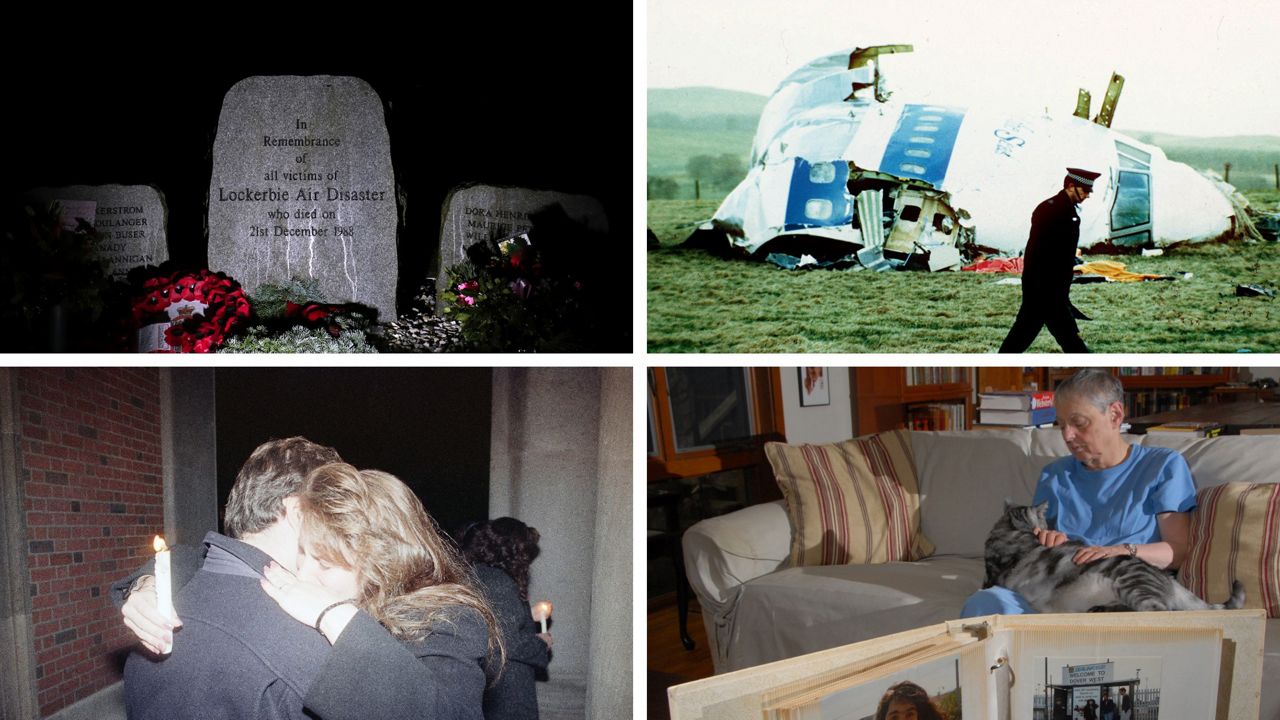LOCKERBIE, SCOTLAND — The fires were still smoldering in Lockerbie when investigators turned their attention to the cause of the disaster. And it did not take long for them to figure out — this was no accident. Pan Am 103 was brought down by a bomb.
“Painstaking and meticulous examination of debris has now led to the conclusion that the explosive device was within a radio-cassette player,” John Orr, the chief Lockerbie investigator, said back in 1988.
Watch Part 4 of Terror and Tears [2008]
“I felt I had entered a parallel universe. Everything was upside down. How can you sit there and learn that somebody bombed the plane with your child on it,” said Susan Cohen, the mother of a Pan Am 103 victim.
“I kept thinking. My gentle, 21-year-old daughter. Whoever would have guessed that somebody would murder her,” said Jeanine Boulanger, the mother of another Flight 103 victim.
Watch The Legacy of Flight 103 [2019]
The man in charge of the Scottish justice system vowed that his people would get it right.
“I think that was probably the worst time in my life. Meeting parents of students from Syracuse University was just awful. Hated it. They were very fine people looking forward to seeing their children back from their new experience in Europe, and they never came home. And I could well understand that sort of sentiment they must have had and what an awful experience it must have been for them,” said Lord Peter Fraser.
Police and military fanned out on foot. They'd eventually scour hundreds of square miles. Technicians studied each bit of material recovered from the Scottish hillside. Detectives studied each lead.
It was the largest murder investigation in British history. And, in the end, it all turned on a piece of evidence so tiny it would fit on a fingertip.
After initially focusing on a possible Iranian connection, more and more attention was turning to Libya and its leader, Moamar Qaddafi. The pattern of Libyan action and U.S. response had been building through the 1980s.
In 1986, the Libyans may have gone too far. A bombing at a discotheque in West Berlin had killed and injured American servicemen. Ronald Reagan said: enough.
“When our citizens are abused or attacked, anywhere in the world, on the direct orders of a hostile regime, we will respond, so long as I'm in this Oval Office,” Reagan said.
American bombs soon rained on Libya.
“We bombed Benghazi. We bombed Tripoli. Tried to kill the leader, Moamar Qaddafi. Killed his adopted daughter. And, we said, score settled. Libyans didn't accept that,” said David Mack, who is with the Middle East Institute.
In August of 1989, invesitgators in Scotland discovered some clothing fragments. Embedded in them was a tiny piece of what had been a circuit board. A circuit board commanding a timer that set off the Lockerbie explosion. It was a brand of timer sold to Libya.
Forensics experts traced the clothing to a shop in the island nation of Malta. The owner of the shop identified the man who had purchased the clothes. The man was a low-level operative in Libyan intelligence named Abdel Basset al-Megrahi.
“We charge that two Libyan officials, acting as operatives of the Libyan Intelligence Service, along with other co-conspirators, planted and detonated the bomb that destroyed Pan Am Flight 103,” said William Barr, who was then the acting Attorney General, in November of 1991.
The second Libyan charged was Khalifa Fhima, a former official of Libyan airlines at Malta's Luqa Airport.
“By using stolen Air Malta baggage tags, the defendants and their co-conspirators were able to route the bomb-rigged suitcase as unaccompanied luggage,” said Barr.
The Justice Department claimed the bomb, hidden in a suitcase, had been placed aboard an Air Malta jet to Frankfurt, and then loaded aboard a feeder Pan Am flight in Frankfurt, eventually finding its way into the cargo hold of Pan Am 103 in London.
There were critics, but the criminal justice system stood its ground.
“What I was interested in is what I regarded as being a quite appalling murder. Two hundred seventy people. You know. Men, women children, students, young babies. The lot. That's what I was concerned with, and I have no doubt that there was a proper case to be brought before the courts to indict these individuals for that responsibility,” Lord Fraser said.
It took years and tough United Nations sanctions, but Libya's government eventually handed over al-Megrahi and Fhima for an unusual trial.
The case would be heard by Scottish judges in a courtroom on neutral land, Camp Zeist, the Netherlands. The proceedings would last for months under the watchful eye of members of victim’s families
“Well, I wanted to kill them. If I could have gone and sat there with an Uzi, I would have shot them dead on the spot. No regrets, even if I got shot for it. And, you want to know something? I still feel the same way,” said Susan Cohen, the mother of a Flight 103 victim.
When the final verdict came 12 years after the bombing, the three-judge panel found al-Megrahi guilty and acquitted Fhima. Al-Megrahi would be handed a life sentence, to be served in a Scottish prison.
The case came to a close at Camp Zeist in January of 2001. It was the closing of the worst terror attack on western soil until nine months later.
“I view, in some ways, Pan Am 103 as an opening skirmish or battle in the terrorism wars of the last 20 years. There have been a number of major battles since then, some of which the U.S. has won, some of which we've lost,” said Paul Hudson, the father of a Flight 103 victim.
“It isn't the peoples that hate each other, it's the governments that caused this. And it's always the innocents who suffer,” said the father of another victim, Robert Hunt.






